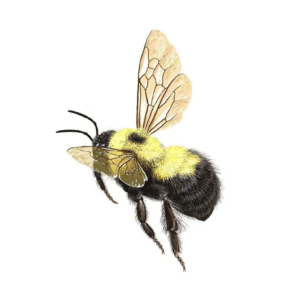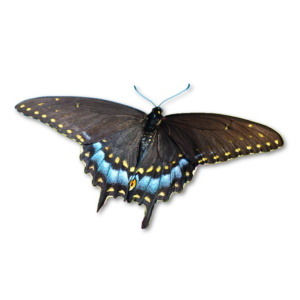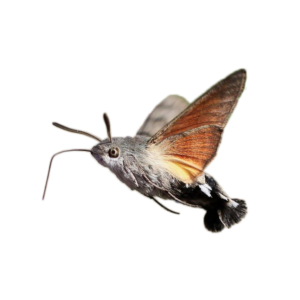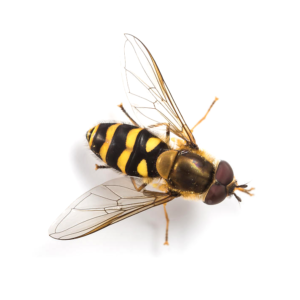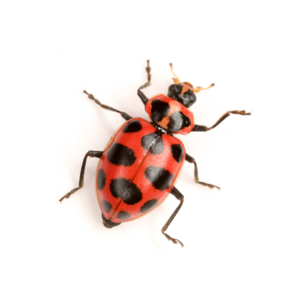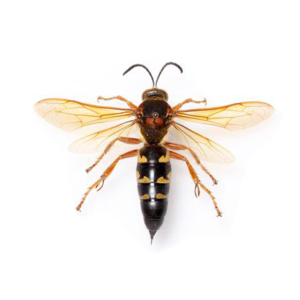Bees
When you mention bees to most people, images of golden-yellow honey bees come to mind. However, there is a lot more to bees than the honey bee. In fact, there are over 20,000 bee species worldwide and around 500 species of bees native to Illinois.
Solitary vs Social
While honey bees live in colonies that can reach 60,000 individuals and bumble bees live in colonies that can reach 400 individuals, most of our native bees (90%) are solitary bees. Unlike honey and bumble bees, that have a division of labor where a queen lays eggs and her offspring perform jobs such as caring for young, foraging, etc., female solitary bees do all these jobs by themselves.
A female solitary bee will select a place to build her nest. Unlike honey bees that live in larger cavities (which is why we are able to keep them in hives), most solitary bees (70%) nest in the ground while others may nest in wood, hollow or pithy branches. Once she has selected a location, she will create nest cells. Inside of these cells she will place a ball of pollen mixed with nectar and lay an egg on it. When the egg hatches, the larva will feed on the pollen ball. Generally, these bees will not emerge until the following year.
Generalist vs Specialist
Many species of bees are generalist pollinators, meaning they will visit a wide variety of different plants. Some, like squash bees, are specialists and may only visit plants from a certain family (cucurbits in the case of squash bees) or even a specific species, like the spring beauty mining bee (Andrena erigeniae), which only collects pollen from spring beauties (Claytonia virginica and Claytonia caroliniana).
Long vs Short-tongued
Bees are also categorized as long and short-tongued. Long-tongued bees have longer tongues and are better adapted to flowers with long corollas like bluebells. Short-tongued bees are better adapted to smaller, shallower flowers like daisies and asters. It is desirable to have both types of flowers available.
s
Pollinator syndrome
Flowers that are visited by bees are often white, yellow, blue or ultraviolet in color. They often have nectar guides and have a fresh, mild, pleasant smell. The flower shape tends to be shallow with a landing platform or tubular.
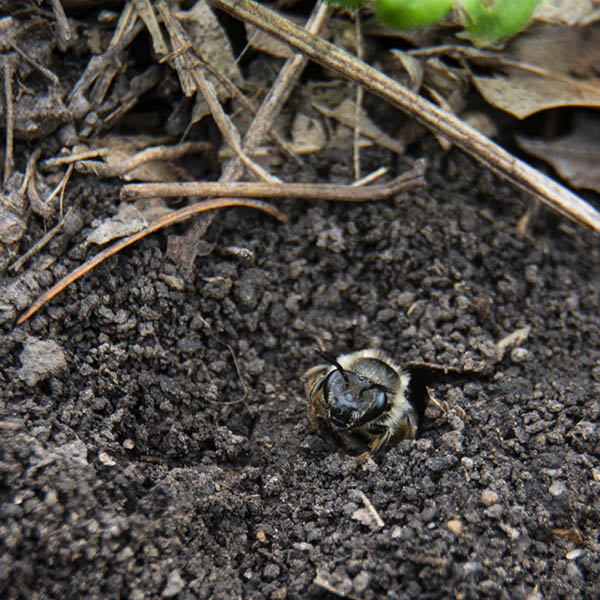
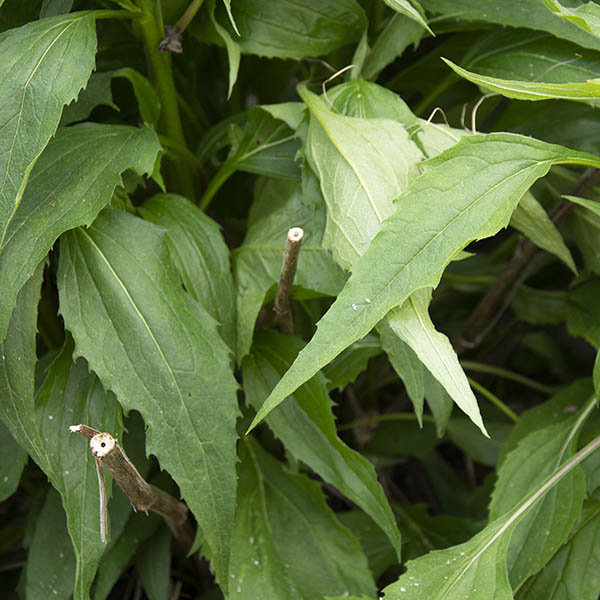
Illinois Bees
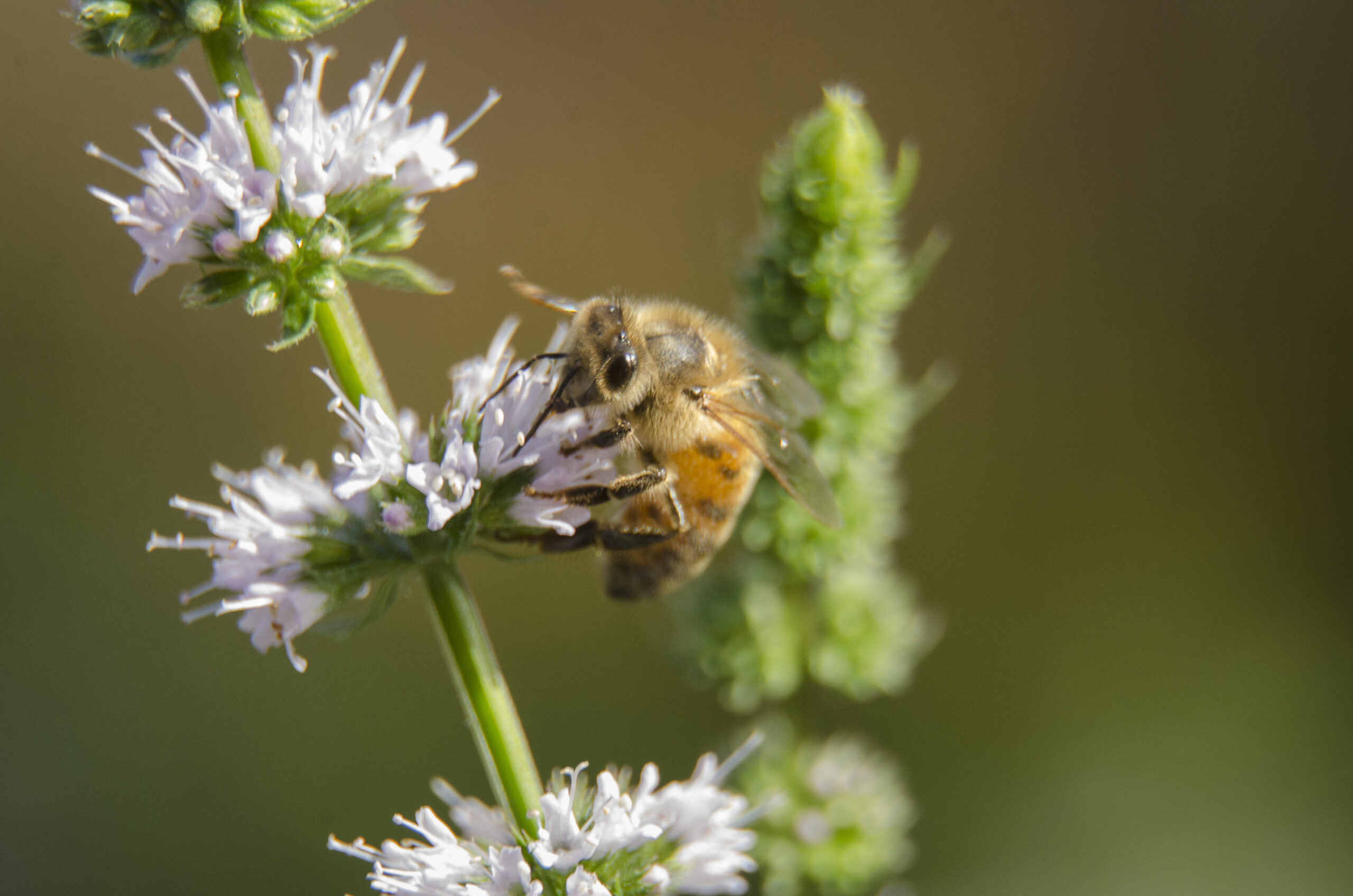
Honey bee—Apis mellifera
These bees are native to Europe, the Middle East, and Africa. Honey bees are social insects and colonies can reach 50,000 individuals. They nest in cavities and are commonly kept by humans in beehives. As they collect nectar from flowers, its used to create honey which sustains the colony during winter. They are generalist pollinators; however, they are often inefficient pollinators of native plants. Honeybees are typically active from early spring to late fall.
Too many honey bee colonies in an area can have a detrimental impact on native bees. A hive with 50,000 workers and a similar number of immature forms can use all the food resources that would otherwise support 100,000 solitary native bees. Having some hives in cities and rural areas is good, but in larger numbers, they can be devastating to other bees.
Description: Medium sized bees (0.4–0.6 in), moderately hairy with a long abdomen with black and gold stripes.
Sweat bee—Halicictidae
Sweat bees are composed of several genera in the family Halictidae. Different species of sweat bees may be solitary or social, and most will nest in the ground. Many species are attracted to human sweat which they will consume for the salt contained in it, thus the common name sweat bees. Sweat bees can be found from spring through fall, with most species being active during the summer. They are generalist pollinators.
Description: Small to medium sized bees (0.1-0.6 in), can be brightly colored or dark; metallic; with markings varying from green to red to yellow, often with bands.
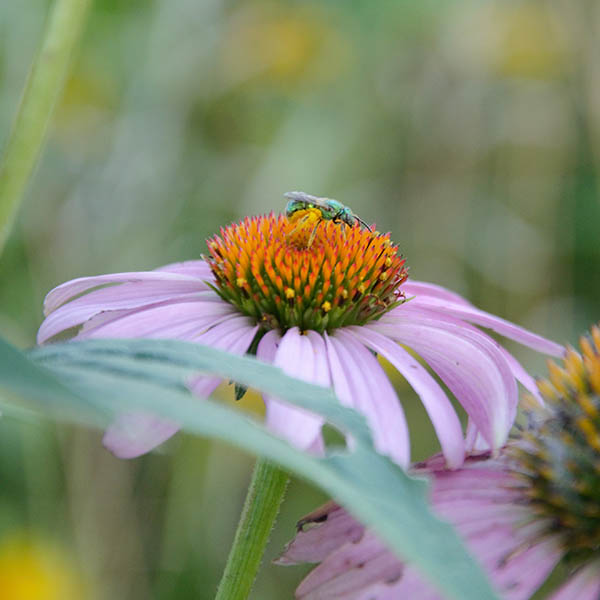

Yellow-faced bees—Hylaeus spp.
These bees resemble wasps and are commonly mistaken for them. Unlike many other bees yellow-faced bees do not have pollen carrying structures (scopae). Instead, they carry pollen in their stomachs (crop) and regurgitate it once they return to their nests. They are solitary bees, nesting in pre-existing tunnels and wood-like stems and twigs. Yellow-faced bees can be found from late spring through late summer. They are generalist pollinators.
Description: Small slender bees (0.2-0.3 in), hairless and black with yellow (sometimes white) markings on face, thorax, and legs.
Leafcutter bees—Megachile spp.
These bees cut circular patches from leaves or petals to line the walls of their nests. They prefer to use leaves with few veins such as rose, ash, maple, lilac and Virginia creeper and the plant damage they seem to create is purely cosmetic. These bees are solitary nesting and create their nests in pre-existing cavities such as beetle galleries or hollow plant stems and will readily nest in man-made nesting blocks. Leaf-cutter bees are active from early to late summer. Most species of leaf-cutter bees are generalists, some species specialize on plants in the aster and pea families. Pollen is carried in a patch of hair on the underside of their abdomen.
Description: Medium to large bees (0.4–0.8 in), smoky colored stout bodies with pale bands with an upturned abdomen.

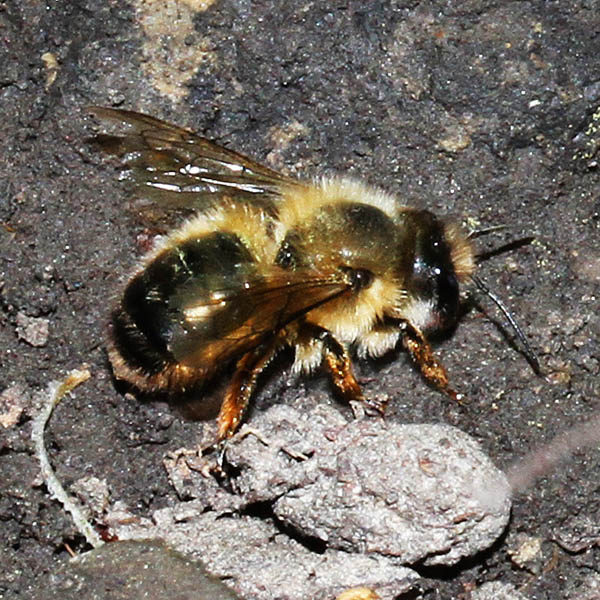
Mason bees—Osmia spp.
Many of these bees collect mud to build walls in their nests to create brood (larval) cells giving them their common name, mason bees. These bees are solitary nesting and create their nests in pre-existing cavities such as beetle galleries, hollow plant stems and will readily nest in man-made nesting blocks. Mason bees are active from spring through early summer. These bees will visit a wide variety of plants and are important pollinators of many fruit crops like apples, cherries, and plums. Pollen is carried in a patch of hair on the underside of their abdomen.
Description: Small to medium bees (0.2–0.4 in), most are metallic in color (blue, green) and round wide abdomens with few, if any, markings or hair bands.
Bumble bees—Bombus spp.
Bumble bees get their name due to the audible buzz they produce while collecting pollen. Certain flowers, such as tomatoes, must be vibrated in order for their pollen to be released (buzz pollination). Bumble bees will grab onto flowers and vibrate their flight muscles (frequency close to a middle C) to release the pollen. Bumble bees are social insects and colonies can have 50-400 individuals. At the end of summer, colonies die off and mated queens hibernate. They nest in cavities such as abandoned rodent burrows. Bumble bees are active from spring through late fall. They are generalist pollinators and are important in the pollination of many food crops.
Description: Medium to large bees (0.4-0.9 in), robust, hairy with yellow, black, white, brown or orange bands.
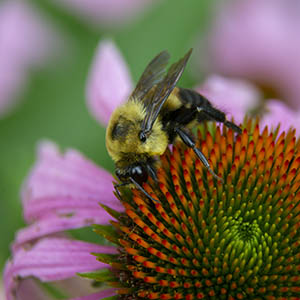
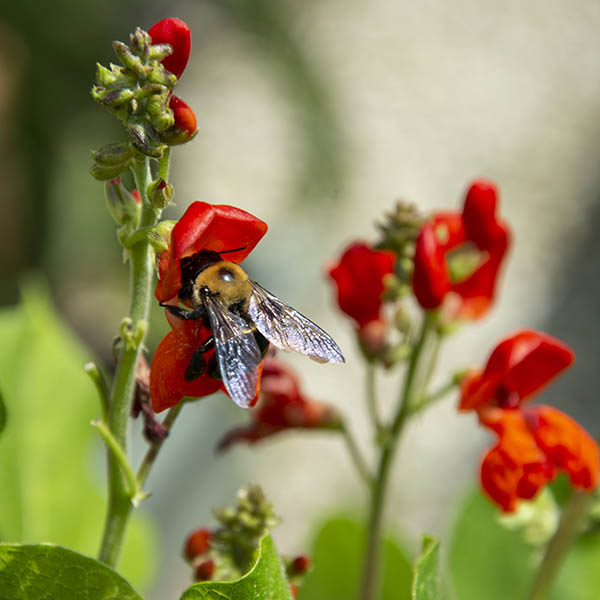
Eastern carpenter bee—Xylocopa virginica
Eastern carpenter bees are commonly considered pests due to their tendency to construct nests in exposed wood of homes and other buildings. They use their strong jaws to chew into soft wood and plant stems to construct tunnels for nests. Painting the wood often deters this activity (Click here for more information on limiting carpenter bee damage). Eastern carpenter bees are mostly solitary, but occasionally groups of two to five females will nest together. They are active from spring through fall. Due to their large size they primarily visit large and open-faced flowers. On smaller flowers, they will sometimes rob nectar by chewing a hole in the side of the flower to access nectar.
Description: Large bees (0.7–0.9 in) that look similar to bumble bees. However, the top of the abdomen of carpenter bees is bare and shiny while a bumble bee’s is hairy.
Small carpenter bees—Ceratina spp.
These carpenter bees have weaker jaws than the larger Eastern carpenter bees (Xylocopa virginica). While they still excavate their own nests, due to their weaker jaws they don’t inhabit solid wood. Instead, they nest in the pithy centers of dead stems such as sunflowers, elderberry, sumac, and blackberries. They are solitary nesters. Small carpenter bees are active from early spring through fall and visit a wide variety of flowers.
Description: Small to medium sized bees (0.1–0.6 in) that are shiny and sparsely haired and black, blue, or green commonly with yellow or white markings on their faces. Their abdomens are unique in being almost cylindrical.

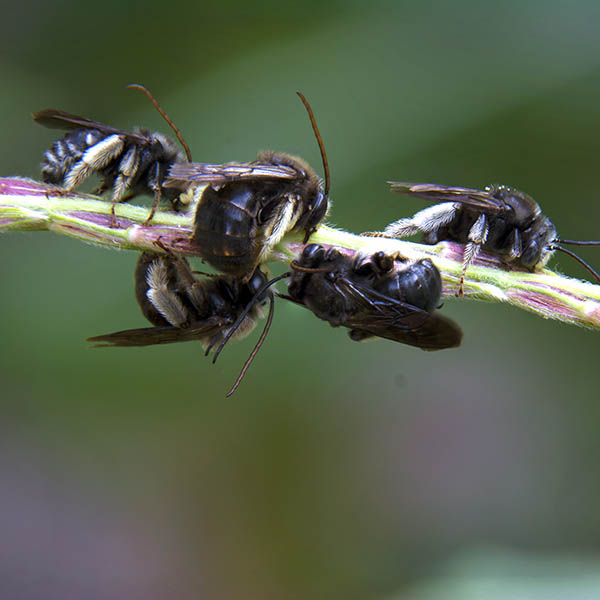
Long-horned bees—Melissodes spp.
Males of these bees have relatively long antennae (females do not) giving them their name. Long-horned bees are solitary ground nesting bees, with most species preferring flat ground. Adult bees are present from mid-summer through fall and are most active in the morning and early afternoon. They have a preference for sunflowers and many species also visit asters. Males often patrol sunflowers for mates and commonly sleep in groups on the heads of sunflowers.
Description: Small to medium sized bees (0.3-0.7 in) that are robust and hairy commonly with abdominal bands of pale hairs.
Mining bees—Andrena spp.
Mining bees are commonly encountered nesting in lawns. These solitary bees nest in the ground, typically in sandy or other loose soils near or underneath shrubs. They often build a small mound outside the entrance of their nests. Mining bees are among the first bees to emerge in spring and are commonly seen in woodlands visiting spring ephemeral wildflowers. Depending on the species, they may be specialists or visit a wide variety of flowers.
Description: Small to medium sized bees (0.3–0.7 in), commonly black, dull metallic blue, or green and somewhat hairy with bands of hair on their abdomens.
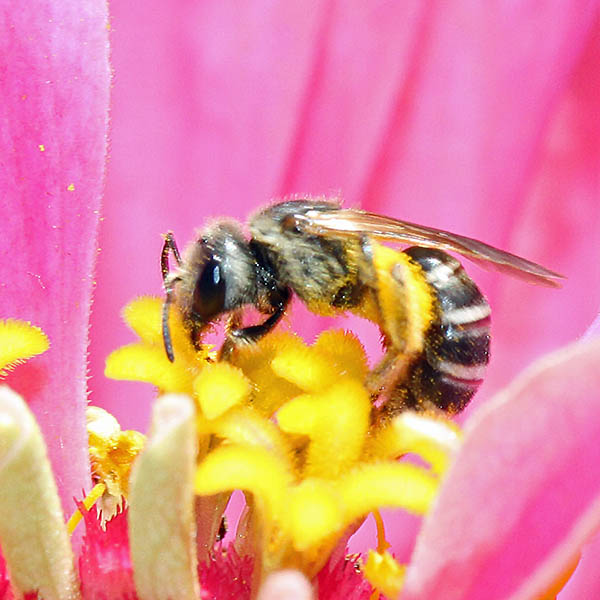
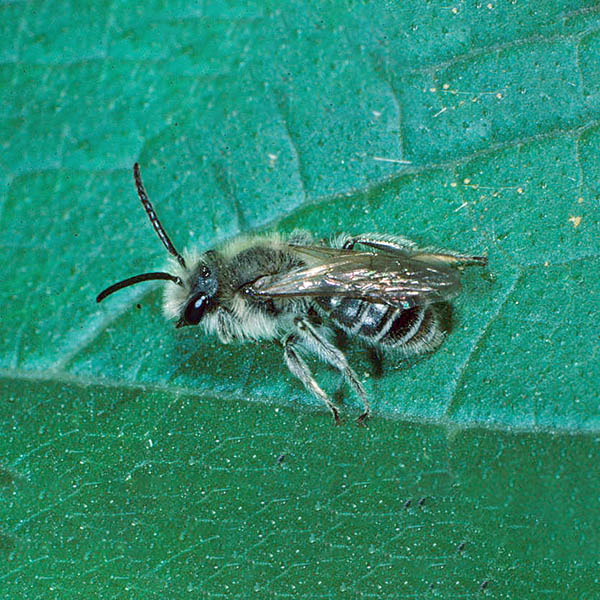
Cellophane (polyester) bees—Colletes spp.
These bees get their name from the waterproof lining of their nests, allowing them to nest in moist soils unavailable to other bees. Most are solitary ground nesting bees; however, some species may nest in large aggregations. They are active from early spring through summer. Many cellophane bees are specialists and only visit a small range of plant species.
Description: Small to medium sized bees (0.3-0.6 in) that are slender and hairy with pale hair bands on their abdomens. When looked at head-on their face looks heart-shaped.
Squash bee—Xenoglossa pruinosa
The squash bee gets its name because it is a specialist on squashes, pumpkins, and gourds. They are much more efficient at pollinating these plants than many other bees such as honey bees. Squash bees are solitary ground nesting bees, often right next to squash plants. Adult bees are active from dawn until midday while squash plants are blooming (mid-summer).
Description: The squash bee is a medium sized bee (0.4–0.6 in) that is similar in appearance to honey bees. However, the squash bee is larger, thicker with longer antennae and a rounder face.



